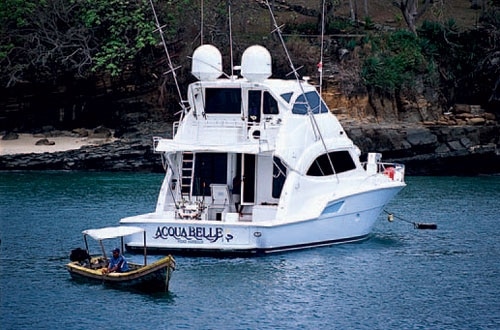
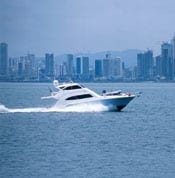
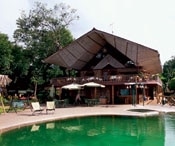
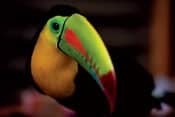
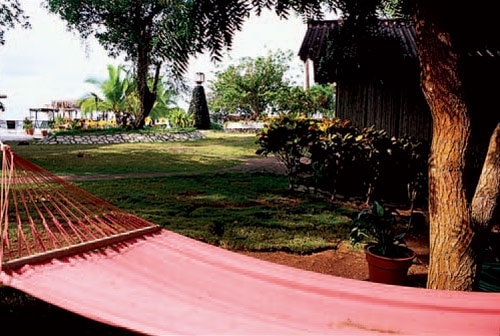
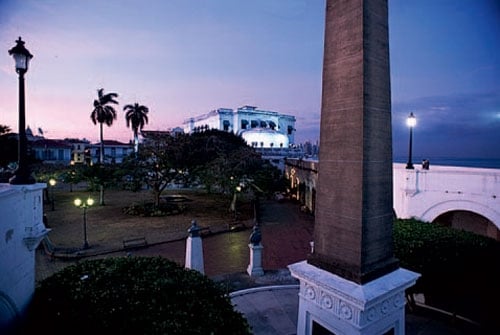
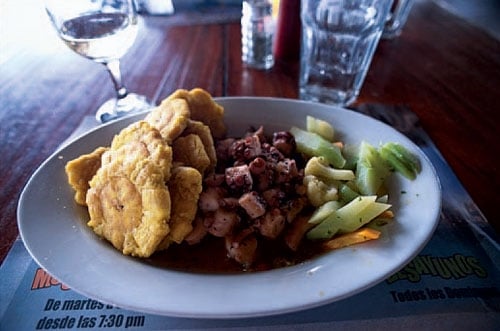
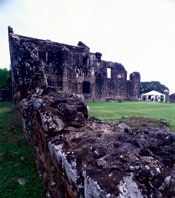
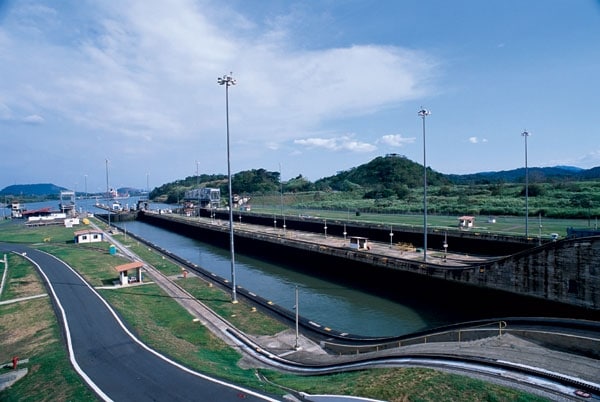
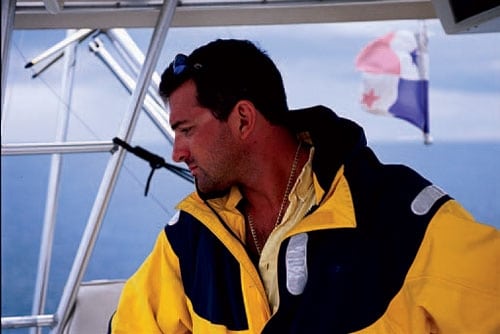
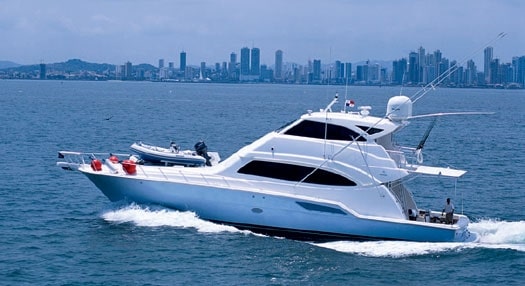

Expect the unexpected in Panama. Where else can you find the sun rising over the Pacific Ocean and setting in the Caribbean? It is an illusion, of course, engendered by the peculiar geography. The scrawny, rawboned isthmus comprising this little nation has been wrenched sideways from the continent’s otherwise southward plunge, as if the gods had tried to twist South America off the North American vine.
One of my favorite places on earth, Panama translates roughly from the Indian as “lots of fish.” So I was excited to be joining Bertram Yachts’ José Millan for a cruise here. My last expedition had been in the company of Felix and Lydia Gonzalez on their 37 Bertram TiTi out of David, the Pacific port city for Chiriqui. A perfect example of how extraordinary Panama can be, David (Da-VEED) squats on the humid coastal plain, one hour north of Volcan Barú, the nation’s highest peak at well over 10,000 feet, in a nearly Alpine setting.
I have also had the pleasure of fishing off the fringe of Darien around Piñas Bay, where the fish are so abundant it staggers the imagination. Tropic Star Lodge, a world-class resort tucked into an otherwise impenetrable rain forest, maintains a fleet of modified Bertram 31s there. (Remember the old ad slogan, “The sun never sets on the Bertram empire”?)
This was to be yet another adventure, a cruise through the Archipiélago de las Perlas, the fabled Pearl Islands, starting from Panama City-founded in 1519 by Pedro Arias de Ávila.
The city prospered as the Spanish used it as entrepôt for the looted treasures of the Inca Empire, which were then transshipped to the Caribbean side on overland trails and thence back to Spain by groaning galleons. It was a city well fortified from attack from the sea. They never thought about the back door.
In 1671, the Welsh pirate Henry Morgan divined the opportunity, muscled his way through the jungle and surprised the city from behind. He sacked, looted and burned and made off with a 200-mule train loaded with treasure.
The Spanish moved the city to a much more easily defended narrow point of land today called Casco Viejo. The ruins of the old city, Panama Viejo, are well preserved in a park-like setting along Via Cincuentenario. They are very impressive, if somewhat clumsily shored up in places by modern brick. The very tip of Casco Viejo is the Plaza Francia, an extremely pleasant place for an evening stroll. Across the bay you can see the twinkling lights of the Bridge of the Americas as it crosses the Pacific end of the Panama Canal.
I met up with José at the Bertram dealership, Evermarine, which is situated in the spanking-new Marina de Isla Flamenco out on the causeway that flanks the entrance to the Canal. Proprietors of this enterprise are Louis and Geno Sola, transplanted Hoosiers.
Our plan was to explore the nearby Pearl Islands in three Bertrams, a 67, a 51 and a 48. The 67, a gorgeous blue-hulled boat named Acqua Belle, was the queen of the fleet. Accordingly, we chartered a fourth, older boat, from the father of Octavio Arias, Evermarine’s operations manager and scion of a very old Panamanian family, and gave chase.
From the sea, Panama City’s explosive growth was even more impressive. High-rise buildings sprout from everywhere. There are still some dangerous neighborhoods, but prosperity is crowding them out. “This is the Dubai of the Western Hemisphere,” Louis Sola told me over dinner one evening. I believe him.
The Pearl Islands are so named for a good reason. When Vasco Nuñez de Balboa found the Pacific Ocean, he also heard stories of the pearls harvested from oysters nearby. His successors managed to kill off the Indians in short order and had to import slaves to help harvest the nacreous treasures. So numerous were they, the Spaniards established a counting house, or contadora, on the large island nearest to the mainland-the same island where Jimmy Carter formally handed over the canal and where Shah Mohammed Reza Pahlavi, the deposed ruler of Iran, found temporary refuge.
The Pearls are a 15-minute flight from Panama City, or a boat ride of an hour or two. The weather usually is not a factor, given that the Pacific is usually that: pacific. That is, calm.
Less than an hour out, we encountered our first treasure. One of the many local shrimp boats was hauling its nets. Capt. Adam MacKenzie, our skipper, asked if I liked shrimp. “Are you kidding?” I said incredulously. “I’m an old South Carolina dude.”
He then brought our craft within hailing distance and in short order, the mate, Cedeño, bartered four packs of Winstons and a six pack of Coke for 15 pounds of fresh, headed shrimp. A little farther on, we were hailed by another shrimp boat. A crewman needed to go home for an emergency. They offered another 15 pounds of shrimp if we’d take him to Contadora. No problem.
After dropping off the crewman, we headed south through the archipelago. The other three boats scattered to their whims, chasing fish or dreams or both. We found ourselves staring in disbelief as we cruised through pods of pilot whales that were being ghosted by orcas-while manta rays belly-flopped and birds screeched over schools of bait fish being chased by everything from dolphin to tuna.
Let me say this: Fishing off the west coast of Panama will spoil you for fishing anywhere else. You’d have to be truly stupid or inept not to catch fish almost anywhere here. When I fished with the Gonzalez family out of David, we played around the offshore islands, Parida and Montuosa, and on down to fabled Hannibal Bank. We caught dolphin, yellowfin tuna, bonito, snapper, sails, a hefty Pacific blue marlin and even rainbow runners while jigging off a seamount.
The most amazing fishing I’ve ever experienced was along the jungle border with Colombia near Piñas Bay around the seamount called Zane Grey Reef. My first day there, we had 60 sailfish bites, with 30-some-odd wired and released. In one day, mind you.
Tropic Star Lodge claims more broken IGFA records than anywhere else in the world. (You may stay and book a boat through the lodge or bring your own yacht and anchor out; www.tropicstar.com.) There is no real dead season, but prime fishing for black marlin is December through April, then the sails move in. Marlin return in July. There is year-round angling for roosterfish, grouper, snapper, rainbow runners, yellowfin tuna, cubera snapper and corvina around the mouth of the Jaqué River. As with all fishing, real success depends on bait, water temperature, winds, etc.. The onset of the rainy season in late April usually brings in the shoals of baitfish.
Birds were everywhere. I have never seen so many frigate birds in one place in my life. Back on the isthmus, I watched a great cyclonic gyre of them spiraling above hordes of sardines. Here, they circled over nesting grounds and joined pelicans in pursuit of food. Yellow-footed boobies skimmed the waters. Squadrons of cormorants profiled the waves.
As we came down the western side of Isla San José, the wind began to pick up. We were coming out of the Gulf and into the edge of the Eastern Pacific and the southerly flow was piling waves onto the shore. Our destination that evening was Hacienda del Mar, a small, rustic but luxurious resort perched on the cliffs.
We passed the guardian islets of Isla Marin, Tres Pilas de Arroz, and Isla de Hicaco into a tight little bay that in most circumstances would be a lovely anchorage. This evening, it bore the brunt of the breeze and was quite choppy.
High on the jagged rock we could see the main lodge, a thatched building constructed after the fashion of an Indian great house. The surf was ferocious, lashing against the cliff. To the left, we could see a lovely scimitar of beach overhung by coconut palms.
Capt. Adam blew the boat’s horn until we finally saw some sign of life. He made fast to a mooring ball and we waited while a small white inflatable made its way toward us. José and I hastily repacked, stuffing enough clothing and shaving tackle for one night into a small duffle and depositing our valuables in my Pelican camera case because it is watertight. We assumed we’d get wet.
Amazingly, the two young men who came to fetch us managed to get us ashore with only wet legs, backing the inflatable into the five-foot surf and expertly grinding us up onto the beach. We jumped out and they went back to get Octavio. Capt. Adam and his crew elected to take the boat around the corner, out of the wind, and anchor there.
We found paradise. This has to be one of the most charming little hotels in the world. There are only 14 rooms, all of them in individual cabins constructed from local materials and cantilevered out over the cliffs, overlooking the beach and the sea. An infinity swimming pool was the centerpiece of the terrace. The dining room was on the second floor of the lodge, with sweeping views. We opted to eat on the balcony outside in the soft air and lambent light. The food was almost as good as the view.
The next morning, we walked around the grounds and listened to raucous macaws shrieking in the treetops. I was trying to photograph some little green parrots on a feeder behind the kitchen when I felt something nibbling gently on my toes. I looked down and beheld a curious toucan.
Later, when I went back to my cabin to pack, I found two toucans on my balcony. They were completely unfazed by humans.
It was with great reluctance that we left this exquisite corner of heaven. I have to tell you that you may reach it by airplane. The resort has its own private little airline that comes into a jungle strip discreetly hidden away. But come in by boat: It’s more fun. And if your yacht is large enough and the wind is calm, anchor off. But as you will want to come ashore for drinks and dinner, be sure to make reservations (www.haciendadelmar.net).
We caught up with the rest of the fleet again back at Contadora for a brief exchange of anecdotes. They spoke of sailfish and marlin and tuna. We told them of toucans and whales and manta rays and orcas with dorsal fins like the sails on attack submarines. Nobody won that battle of the tall stories. It was a happy draw.
Contact: Bertram; www.bertram.com









